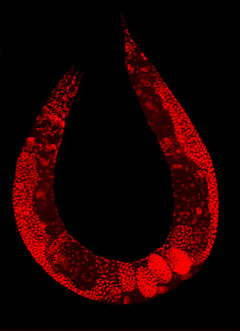If androids dream of electronic sheep, then what do microscopic worms dream of? This question might never be answered, but Samy Belfer, a senior in the Biological Basis of Behavior major, says they are capable of explaining more than we might think about sleep.
“We have sort of cliché explanations of the effects of sleep,” says Belfer. “But these are ultimately governed by neuronal mechanisms and by our DNA on the most basic level. This is what we’re exploring.”
Belfer started working with C. elegans, a species of worm which displays sexual dimorphism, at the University of Rochester. The worms present as males and hermaphrodites and have sex-specific neurons, but also have a variety of shared neuronal pathways. This combination results in sex-specific behaviors. Generation time for a fresh batch of specimens is extremely short, which allows for a brand new population every single day—a distinct advantage for researchers. Belfer soon transitioned to Penn to continue his work on the worms in the lab of David Raizen, Assistant Professor of Neurology.
C. elegans are nematodes that grow to about one millimeter in size as adults. They have four different larval stages after hatching. In between these larval stages is a period of quiescence called “lethargus,” the closest thing to sleep in worms. Belfer’s trials zero in on this specific period due to the cessation of locomotion, feeding and foraging behavior. A number of methods are used to stimulate the worms, including food concentrations, mechanical stimuli like tapping and pungent smells. Using a hyperarousable genetically modified C. elegans, Belfer is able to analyze a specific subset of neurons that governs behavior when there is a lack of sleep.
“We don’t know where this gene is acting among the 302 neurons of the worm,” says Belfer. “But we can look at smaller and smaller subsets of neurons by controlling gene expression using specific DNA elements.”
Belfer plans to use this model eventually to understand which neurons, proteins and genes project onto more complex organisms. A new device that divides a plastic chip into tiny compartments—called a microfluidics apparatus—will allow for the more intensive study of mutants. Worms are loaded into the microscopic spaces in the chip and pictures are taken every second. If the worm moves from point A to point B, it will be apparent based on light and dark tones in the pixels of the picture. The precision of this new device, combined with the ability to pinpoint specific neuronal behavior using genetic perturbations, might eventually prove useful in diagnosing sleep disorders in bigger organisms, possibly even mammals.
“Working with David has been unbelievable. He’s been a mentor to me from day one. And the most important thing is he treats me like I should know everything,” Belfer laughs, “which inspires me to keep learning.”
Belfer is currently co-authoring a paper with Raizen which will be based on findings using the new microfluidics apparatus.



